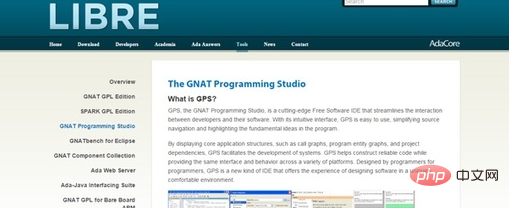 Operation and Maintenance
Operation and Maintenance
 Linux Operation and Maintenance
Linux Operation and Maintenance
 What are the C programming software on Linux?
What are the C programming software on Linux?
What are the C programming software on Linux?
C programming software on Linux includes: 1. eclipse, which can provide open source tools and environments for C and C programmers; 2. "Code::Blocks", which supports code compilation, debugging, code coverage, and analysis and automatic completion; 3. CodeLite, an open source cross-platform IDE; 4. NetBeans, etc.

#The operating environment of this tutorial: linux5.9.8 system, Dell G3 computer.
C/C is popular worldwide and indispensable in application and system development.
Decades have passed, C and C, as the main high-level programming languages, are still very popular around the world, and firmly occupy the top 5 of the TIOBE programming language rankings, applications and System development is inseparable from these two languages.
In this article, we will show you some programming software (IDE) for C/C that can be found on the Linux platform.
linux C programming software (IDE)
1) eclipse
Eclipse is the world’s most The most popular and powerful IDE. It provides open source tools and environments for C and C programmers. Beginners will find it very easy to get started using this IDE.

Features:
Freely available open source software.
Supports various platforms such as Windows, Linux, Mac OS X, etc.
Supports code debugging, compilation, analysis, automatic completion and reconstruction (code reorganization can be performed without changing the external operation).
Has a great Graphical User Interface (GUI) to arrange elements using drag and drop functionality.
Support static code analysis
2) Code::Blocks
Code::Blocks It is an open source, full-featured cross-platform C/C integrated development environment. This IDE contains all the features you need for C and C++ development.

Features:
Available for Windows, Linux and Mac OS X.
Fully customizable and scalable.
Supports code compilation, debugging, code coverage, analysis and automatic completion.
is a class browser. That is to say, it can visualize object-oriented programming.
Have features like Eclipse that allow you to use drag-and-drop functionality when arranging elements, and also support code analysis.
3) GNAT Programming Studio
GNAT Programming Studio, referred to as GPS, is a highly simplified interaction between software and developers. Advanced free IDE. GPS's natural interface makes it easy to use, simplifies the navigation of the source program, and also helps to highlight the basic ideas of the program.

Features:
Multi-platform support.
Supports code compilation, debugging, code coverage, analysis and automatic completion.
is also a class browser similar to Code:Blocks and also supports code refactoring.
Its drag and drop feature eases the programmer’s work
4) CodeLite
CodeLite It is a free, open source, cross-platform IDE created specifically for developers of C, C, PHP and JavaScript (mainly for node.js) programming languages. It can run on all major platforms (Windows, macOS and Linux)
Features:
Supports universal compilers and can click on errors through Buildtab.
Support next generation debugger.
Have an incredibly fast and powerful code completion tool based on an internal parser.
also has application-based RAD tools for building plug-ins.
Supports static code analysis, refactoring, class browser and program profiling.
5) NetBeans
Netbeans C IDE contains many projects based on C and C templates, providing C and C dynamic and static libraries to build applications. Its magical properties make it widely popular among web developers.
Features:
Free and open source IDE.
Multiple platform support.
Code completion is fast and supports C/C refactoring.
Well integrated multi-session gdb debugger.
It has functions such as automatic indentation, semantic highlighting, formatting (you can choose the formatting style), code folding, bracket matching and templates.
You can use development tools on the remote host to create, execute and even debug projects on the client system in a simple way.
6) Qt Creator
Qt Creator is another cross-platform IDE. Its design goal is to enable developers to use the Qt application framework to complete development tasks more quickly and easily.
Features:
Multi-platform support.
Supports code compilation, debugging, analysis, automatic completion and reconstruction.
Can be dragged and dropped freely.
Support static code analysis.
7) Anjuta
Anjuta is an all-round IDE that contains many advanced programming tools. It focuses on efficient development for developers. Provides a simple and usable interface. Although it is open source software, it only supports the Linux platform.
Features:
Anjuta UI is simple to operate and powerful.
Has simple wizards and templates for creating new projects.
Fully integrated with the debugging function of GDB.
project management.
Application Wizard.
Source code editor.
Analyzers and more.
8) MonoDevelop
MonoDevelop enables developers to write desktop and web applications on Linux, Windows and Mac OS X platforms. You can also write .NET applications created in Visual Studio on Linux and Mac OS X platforms using a code base that is the same and unique for all platforms.
Features:
Multi-platform support.
Advanced text editing
Multi-language support.
Integrated debugger.
Configurable workbench.
Web projects can be created entirely using code auto-completion.
9) CLion
CLion is a tool from Jetbrains that helps developers perform C and C on Linux, OS X and Windows platforms. A powerful IDE, CLion can effectively improve developer productivity through smart editors, code quality assurance tools, automatic refactoring tools, and tightly integrated CMake build systems.
Features:
Multi-platform support.
Supports various languages and standards.
Integrated version control system.
Embedded terminal system.
Smart editor.
Supports code compilation, debugging, analysis, automatic completion and reconstruction.
Supported by CMake system.
Related recommendations: "Linux Video Tutorial"
The above is the detailed content of What are the C programming software on Linux?. For more information, please follow other related articles on the PHP Chinese website!

Hot AI Tools

Undresser.AI Undress
AI-powered app for creating realistic nude photos

AI Clothes Remover
Online AI tool for removing clothes from photos.

Undress AI Tool
Undress images for free

Clothoff.io
AI clothes remover

Video Face Swap
Swap faces in any video effortlessly with our completely free AI face swap tool!

Hot Article

Hot Tools

Notepad++7.3.1
Easy-to-use and free code editor

SublimeText3 Chinese version
Chinese version, very easy to use

Zend Studio 13.0.1
Powerful PHP integrated development environment

Dreamweaver CS6
Visual web development tools

SublimeText3 Mac version
God-level code editing software (SublimeText3)

Hot Topics
 1669
1669
 14
14
 1428
1428
 52
52
 1329
1329
 25
25
 1273
1273
 29
29
 1256
1256
 24
24
 Linux Architecture: Unveiling the 5 Basic Components
Apr 20, 2025 am 12:04 AM
Linux Architecture: Unveiling the 5 Basic Components
Apr 20, 2025 am 12:04 AM
The five basic components of the Linux system are: 1. Kernel, 2. System library, 3. System utilities, 4. Graphical user interface, 5. Applications. The kernel manages hardware resources, the system library provides precompiled functions, system utilities are used for system management, the GUI provides visual interaction, and applications use these components to implement functions.
 vscode Previous Next Shortcut Key
Apr 15, 2025 pm 10:51 PM
vscode Previous Next Shortcut Key
Apr 15, 2025 pm 10:51 PM
VS Code One-step/Next step shortcut key usage: One-step (backward): Windows/Linux: Ctrl ←; macOS: Cmd ←Next step (forward): Windows/Linux: Ctrl →; macOS: Cmd →
 How to check the warehouse address of git
Apr 17, 2025 pm 01:54 PM
How to check the warehouse address of git
Apr 17, 2025 pm 01:54 PM
To view the Git repository address, perform the following steps: 1. Open the command line and navigate to the repository directory; 2. Run the "git remote -v" command; 3. View the repository name in the output and its corresponding address.
 How to run java code in notepad
Apr 16, 2025 pm 07:39 PM
How to run java code in notepad
Apr 16, 2025 pm 07:39 PM
Although Notepad cannot run Java code directly, it can be achieved by using other tools: using the command line compiler (javac) to generate a bytecode file (filename.class). Use the Java interpreter (java) to interpret bytecode, execute the code, and output the result.
 How to run sublime after writing the code
Apr 16, 2025 am 08:51 AM
How to run sublime after writing the code
Apr 16, 2025 am 08:51 AM
There are six ways to run code in Sublime: through hotkeys, menus, build systems, command lines, set default build systems, and custom build commands, and run individual files/projects by right-clicking on projects/files. The build system availability depends on the installation of Sublime Text.
 What is the main purpose of Linux?
Apr 16, 2025 am 12:19 AM
What is the main purpose of Linux?
Apr 16, 2025 am 12:19 AM
The main uses of Linux include: 1. Server operating system, 2. Embedded system, 3. Desktop operating system, 4. Development and testing environment. Linux excels in these areas, providing stability, security and efficient development tools.
 laravel installation code
Apr 18, 2025 pm 12:30 PM
laravel installation code
Apr 18, 2025 pm 12:30 PM
To install Laravel, follow these steps in sequence: Install Composer (for macOS/Linux and Windows) Install Laravel Installer Create a new project Start Service Access Application (URL: http://127.0.0.1:8000) Set up the database connection (if required)
 git software installation
Apr 17, 2025 am 11:57 AM
git software installation
Apr 17, 2025 am 11:57 AM
Installing Git software includes the following steps: Download the installation package and run the installation package to verify the installation configuration Git installation Git Bash (Windows only)





